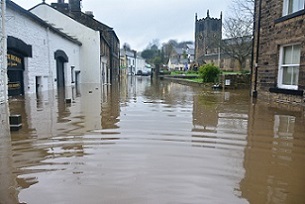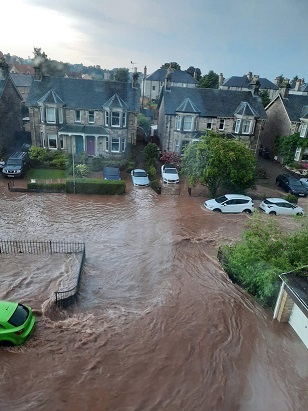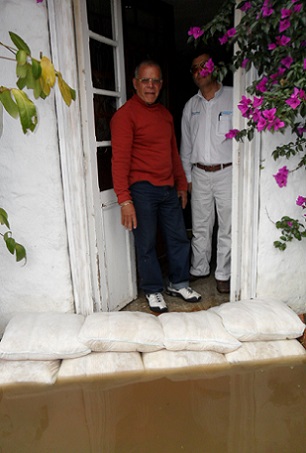 Flooding can devastate local communities. Photo by Chris Gallagher on Unsplash.
Flooding can devastate local communities. Photo by Chris Gallagher on Unsplash.
 Flooding in Perth, Scotland, August 2020. Photo by Arran McKay.
Flooding in Perth, Scotland, August 2020. Photo by Arran McKay.
 FloodSax alternative sandbags are highly effective at keeping flooding out of homes and businesses
FloodSax alternative sandbags are highly effective at keeping flooding out of homes and businesses
Climate change and flooding is constantly in the news these days but how can you be prepared to avoid the risk of flooding for your home and business?
Well, here are all the direct website links to all the organisations that can help.
It’s estimated that one in five properties in the UK are at risk from flooding and, as we’ve seen this summer, this can happen anywhere and at any time with catastrophic flash flooding in London causing millions, if not billions, pounds of damage.
Rising insurance claims are sure to make insurance premiums more expensive for us all.
Camilla Yates from price comparison website MoneySuperMarket, recently told the Guardian that insurers will inevitably increase prices with homes in flood-risk areas likely to see the biggest rises.
She said: “Providers are constantly monitoring risks and adjusting prices in line with the cover they provide which means that for every year in which we see more flooding there is the potential for prices to go up.”
People usually regard autumn and winter as the wettest seasons – think of the Boxing Day floods in 2015 – but summer flooding can be horrendous with London badly hit this July and many people will remember the horrendous Boscastle flood in Cornwall in August 2004.
The average premium for buildings and contents insurance in 2020 was £314, according to the Association of British Insurers.
But with the average household flood claim now £32,000 – way higher than the average claim for a burglary – and flooding happening more and more, the insurance costs can only keep spiralling upwards. Damage caused by flooding is so extensive it’s known as “the thief who takes everything.”
Here are some quick ways to avoid the risk of your home or business flooding with the direct website links you’ll need.
* Be prepared. The Environment Agency is clear that people are responsible for their own flood protection and that specialist flood mitigation products are better than traditional sandbags.
The Environment Agency states: “Don’t assume the authorities will provide you with sandbags in a flood emergency. It is the responsibility of property owners to take appropriate action to protect their property from flooding. Sandbags are relatively ineffective when compared to purpose-built flood protection products. We strongly encourage people to use these products.”
Many councils now recommend FloodSax alternative sandbags (http://www.floodsax.co.uk/) but there are many anti-flood devices on the market and the quickest way to see them all is to go onto the Blue Pages flood products directory (http://bluepages.org.uk/) on the flood charity the National Flood Forum’s website (https://nationalfloodforum.org.uk/).
* Check the Environment Agency’s website which will tell you if your property is at risk or is in an area that’s likely to flood in the future (https://www.gov.uk/check-flood-risk). The agency can also prepare a report on the flooding history of a property which is useful if you are planning to move or if you have concerns about your existing home. If it takes less than 18 hours to prepare it’s free. But if it takes longer it will cost at least £450. You will then be offered the chance to decide if you want go ahead. To look at getting a report email the Environment Agency at enquiries@environment-agency.gov.uk
* Double check your insurance policy includes cover for flooding. It’s always best to shop around for the best insurance cover using price comparison websites such as Compare the Market (https://www.comparethemarket.com/home-insurance/flood/), Go Compare (https://www.gocompare.com/home-insurance/flooding-and-home-insurance/) or Money SuperMarket (https://www.moneysupermarket.com/home-insurance/flood-insurance/) but don’t look for the cheapest, look for the one that best suits your needs.
* See if you qualify for inexpensive insurance cover under the Flood Re (https://www.floodre.co.uk/) scheme – the Government’s scheme that provides subsidised insurance. Up to now 350,000 properties in the UK have qualified for the scheme and in 2020-21, Flood Re provided cover for a total of 218,090 policies to homes across the UK. To qualify, your property must be built before 2009 and be in an area at risk of flooding. All flood insurance companies pay into Flood Re every year which brings in £180m to help those in high risk flood areas to get affordable insurance.
* If you’re buying a newly built home ask the builder if it has any flood mitigation measures and, if not, make sure you get something to provide you with flood protection in an emergency such as FloodSax sandless sandbags which are space-saving to store and quick and easy to deploy. Local authorities won’t come running with traditional sandbags to help you if flooding is imminent.
* If you are in dispute with an insurance company over a flooding claim you can always ask the National Flood Forum for advice and support.
* Consider joining your local Flood Action Group (FAG) run by residents and volunteers to reduce the risk of floods in their area. They typically liaise with agencies and councils to tackle risks so you’ll be naturally more aware of the flooding hazards where you live.
* Don’t buy a house or set up a business on a flood plain or in an area that’s vulnerable to flooding.